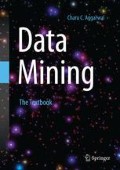Abstract
Many applications require the partitioning of data points into intuitively similar groups. The partitioning of a large number of data points into a smaller number of groups helps greatly in summarizing the data and understanding it for a variety of data mining applications.
Access this chapter
Tax calculation will be finalised at checkout
Purchases are for personal use only
Notes
- 1.
For a fixed cluster assignment \({\cal C}_1 \ldots {\cal C}_k\), the gradient of the clustering objective function \(\sum _{j=1}^k \sum _{ \overline {X_i} \in {\cal C}_j} || \overline {X_i} - \overline {Y_j}||^2\) with respect to \(\overline {Y_j}\) is \(2 \sum _{ \overline {X_i} \in {\cal C}_j} (\overline {X_i} - \overline {Y_j})\). Setting the gradient to 0 yields the mean of cluster \({\cal C}_j\) as the optimum value of \(\overline {Y_j}\). Note that the other clusters do not contribute to the gradient, and, therefore, the approach effectively optimizes the local clustering objective function for \({\cal C}_j\).
- 2.
- 3.
This is achieved by setting the partial derivative of \({\cal L}({\cal D}|{\cal M})\) (see Eq. 6.12) with respect to each parameter in \(\overline {\mu _i}\) and \(\sigma \) to 0.
- 4.
The parameter \(MinPts\) is used in the original DBSCAN description. However, the notation τ is used here to retain consistency with the grid-clustering description.
- 5.
See [257], which is a graph-based alternative to the LOF algorithm for locality-sensitive outlier analysis.
Author information
Authors and Affiliations
Corresponding author
Rights and permissions
Copyright information
© 2015 Springer International Publishing Switzerland
About this chapter
Cite this chapter
Aggarwal, C. (2015). Cluster Analysis. In: Data Mining. Springer, Cham. https://doi.org/10.1007/978-3-319-14142-8_6
Download citation
DOI: https://doi.org/10.1007/978-3-319-14142-8_6
Published:
Publisher Name: Springer, Cham
Print ISBN: 978-3-319-14141-1
Online ISBN: 978-3-319-14142-8
eBook Packages: Computer ScienceComputer Science (R0)

